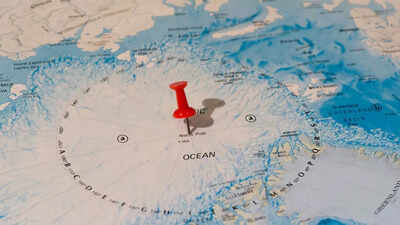Trending
Climate change isn’t just heating Earth, it’s tilting it: This is how it will impact us
Climate change is causing a significant redistribution of mass on Earth due to melting ice sheets, leading to a shift in the planet's geographic poles. By 2100, the North Pole could move westward by as much as 89 feet under worst-case warming scenarios. This shift, surpassing natural adjustments, could disrupt satellite systems and global navigation tools.
Climate change is not just warming the planet, it’s also changing how it is shaped by being hidden in plain sight. While most of us are familiar with the visible impacts of global warming, such as rising sea levels, melting glaciers, and stronger storms, there's also another side of these consequences that is occurring quietly, and this is the physical rebalancing of our planet.
As temperatures are on a constant rise and ice sheets continue to melt at an increased pace, the distribution of mass on Earth is also changing. And it is surprising to know that it isn't just a subtle shift, but as the scientists say, it's sufficient to shift the planet's geographic poles.
The North and South Poles are not fixed points. Instead, they shift over time due to natural factors like changes in Earth’s core, mantle convection, and ocean currents. But now, human-caused climate change has come up as a major reason for this shift.
Poll
Do you believe the shifting of the North Pole could impact global navigation systems?

Earth’s poles are shifting!
A new study has found that by the year 2100, the North Pole could shift by a massive area that nearly equals the length of a Boeing 737, in the worst-case scenario. Such a movement could disrupt satellite systems and global navigation tools that rely on precise pole positioning to function.
What does the study suggest?
The researchers studied data from 1900 to 2018 and used simulations to model how the melting of ice sheets and glaciers will affect Earth’s poles by the end of the century. If global temperatures rise at the worst predicted rates, the North Pole could move more than 89 feet westward. Even under moderate climate scenarios, a shift of around 39 feet is still expected when compared to the pole’s position in 1900.

“This effect is somewhat surpassing the effect of glacial isostatic adjustment, which is the effect of solid Earth rebound after the termination of the last ice age,” study co-author Mostafa Kiani Shahvandi, an Earth scientist at the University of Vienna, told Live Science. “This means that what humans have done has somewhat shifted the pole more than the effect of ice ages.”
What is Glacial isostatic adjustment?
Glacial isostatic adjustment means the rise of land that was previously compressed under massive glaciers during the last Ice Age. While this process still impacts the Earth's mass distribution, the new study shows changes that are a result of human activity, like the large-scale melting of ice sheets, which are now the most impactful force.

In addition to affecting Earth’s orientation, this shift could have real-world technological consequences. “Earth's rotation axis is used in part to map a spacecraft's location,” the researchers said. A shift of this scale could disrupt satellite navigation, spacecraft tracking, and even systems like GPS, which are calibrated using Earth’s current rotational axis.
End of Article
Follow Us On Social Media
Visual Stories
Tired of too many ads?









